An online project under the direction of the CAPE ANN MUSEUM
inv. 629
Bark "Mary"
Oil on canvas 19 1/2 x 27 in. (49.5 x 68.6 cm) No inscription found
Private collection
|
Supplementary Images
Explore catalog entries by keywords view all keywords »
Historical Materials
Below is historical information related to the Lane work above. To see complete information on a subject on the Historical Materials page, click on the subject name (in bold and underlined).
The merchant bark “Mary” (268 register tons) was built at Medford, Massachusetts in 1844 by Foster & Taylor for Nathaniel Francis of Boston. The vessel’s construction was overseen by her master, a Captain Hopner, who commanded her for the three years under Francis’s ownership. (1).
Other accounts and records of this vessel differ considerably. Hall Gleason states that she was sold to New York parties, and in 1854 on a run from New Orleans to Stockholm, she was wrecked on Los Colorados Reef, Cuba, in September 1854, and burned (2).
An unidentified surveyor’s tabulation of American vessels, ca. 1860, records “Mary” as surveyed in 1858 at Boston, listing N. Francis as owner and Hopner as captain (see table below)
In Cutler’s history of American packet ships, “Mary” (268 tons) is listed as a “ship” (not a bark) under the management of the Packet Line of Boston in 1847 with Nathaniel Francis as master. The Packet Line was a coastal line with agents in Boston and New Orleans. (3).
In his six-volume treatise, “Merchant Sail”, William Armstrong Fairburn listed 58 vessels with the name “Mary”, none of them having the combination of rig, tonnage, and building date matching the “Mary” depicted by Lane. Have her official records all been lost?
–Erik Ronnberg
References:
1. Nathaniel Francis, “Sketch of Reminiscences of Former Years Requested by Nathaniel Francis, Son of the Author” (Boston: typescript copy of probable manuscript, April 19, 18670.
2. Hall Gleason, “Old Ships and Ship-building Days of Medford, 1630-1873” (West Medford, MA: published by the author, 1936), p. 66.
3. Carl C. Cutler, “Queens of the Western Ocean” (Annapolis, MD: U.S. Naval Institute Press, 1961), p. 449.
"October 1, 1844 contracted for the building of the bark Mary (named for my wife) with Mr. Foster and Taylor. Was successful in building and completing. She was a good white oak vessel. Was about 300 tons and superintended by Capt. Hopner. She was owned by myself 5/8 Mr. Lovell 1/8 Mr. Torsleff 1/8 Capt. Hopner 1/8 and was commanded by Capt. Hopner who as as I consider one of the best ship masters that sailed out of Boston without exception. . . .We sailed the bark Mary for three years after making three successful voyages, taking each about one year going from Boston to Norfolk and to Rio and St. Petersburg and Boston and then sold her to Wm. H. Boadman for the sum of $16,500 being about what she cost when new and she had about paid for herself."
Also filed under: Shipbuilding / Repair »
In the ninteenth century, the term "bark" was applied to a large sailing vessel having three masts, the first two (fore and main) being square-rigged; the third (mizzen), fore-and-aft rigged. The reduced square-rig made the vessel easier and more economical to handle, using a smaller crew. (1)
Barks had significant presence in mid-nineteenth-century America, as indicated by Lane’s depictions of them. Hardly any are to be found in his scenes of major ports, but some do appear in his Cape Ann scenes (see The Fort and Ten Pound Island, Gloucester (Harbor Scene), 1848 (inv. 58), View of Gloucester, 1859 (inv. 91), Gloucester Harbor, 1850s (inv. 391), and Bark "Eastern Star" of Boston, 1853 (inv. 571)), also in views of other small ports and of coastal shipping (see Clipper Ship "Southern Cross" in Boston Harbor, 1851 (inv. 253), Merchantmen Off Boston Harbor, 1853 (inv. 267), Approaching Storm, Owl's Head, 1860 (inv. 399), and Bark "Mary" (inv. 629)).
Brigs, and to a lesser extent ships, were the vessels of choice for Gloucester’s foreign trade in the first half of the nineteenth century. They brought cargos from the West Indies, South America, and Europe, anchoring in the deeper parts of the Inner Harbor while lighters off-loaded the goods and landed them at the wharves in Harbor Cove, by then too shallow for the newer, larger merchant vessels coming into use. (2) By mid-century, barks were gradually replacing brigs and ships, while the trade with Surinam was removed to Boston in 1860. (3)
Some bulk cargos still had to be landed in Gloucester, salt for curing fish being the most important. “Salt barks” brought Tortugas salt from the West Indies, and in the 1870s, Italian salt barks began bringing Trapani salt from Sicily. The importation of salt by sailing ships ended with the outbreak of World War I. (4)
The term barkentine, like the bark, pre-dates the nineteenth century, but in the mid- to late 1800s referred to a large vessel of three masts (or more), with only the fore mast square-rigged, the others being fore-and-aft-rigged. In Lane’s time, the term was little known in the United States, while many other names were coined for the rig. One of these early terms was demi-bark, probably from the French demi-barque, which was applied to a very different kind of vessel. (5) Lane’s depictions of these rigs include a lithograph of the steam demi-bark "Antelope" View of Newburyport, (From Salisbury), 1845 (inv. 499) and at least three depictions of Cunard steamships The "Britannia" Entering Boston Harbor, 1848 (inv. 49), Cunard Steamship Entering Boston Harbor (inv. 197), and Cunard Liner "Britannia", 1842 (inv. 259). (6) None of these subjects typify the barkentine rig as applied to sails-only rigs as they developed in the years after Lane’s death.
– Erik Ronnberg (May, 2015)
References:
1. R[ichard] H[enry] Dana, Jr., The Seaman's Friend (Boston; Thomas Groom & Co., 1841. 13th ed., 1873), 97 and Plate IV with captions; and M.H. Parry, et al., Aak to Zumbra: A Dictionary of the World's Watercraft (Newport News, VA: The Mariners’ Museum, 2000), 43.
2. Alfred Mansfield Brooks, Gloucester Recollected (Gloucester, MA: Peter Smith, 1974), 56, note 10; 67, note 7.
3. James R. Pringle, History of the Town and City of Gloucester (1892. Reprint: Gloucester, MA, 1997), 106–08.
4. Raymond McFarland, A History of the New England Fisheries (Philadelphia: University of Pennsylvania, 1911), 95–96; and Mark Kurlansky, Salt: A World History (New York: Walker & Co., 2002), 419–420.
5. Parry, 44, 167. Dana has neither definition nor illustration of this rig.
6. J[ohn] W. Griffiths, “The Japan and China Propeller Antelope," U.S. Nautical Magazine III (October 1855): 11–17. This article includes an impression of Lane’s lithograph on folded tissue.
Stereograph card
Cape Ann Museum Library & Archive
This view of Gloucester's Inner Harbor shows three square-rigged vessels in the salt trade at anchor. The one at left is a (full-rigged) ship; the other two are barks. By the nature of their cargos, they were known as "salt ships" and "salt barks" respectively. Due to their draft (too deep to unload at wharfside) they were partially unloaded at anchor by "lighters" before being brought to the wharves for final unloading.
– Erik Ronnberg
Also filed under: Historic Photographs » // Salt » // Waterfront, Gloucester »
The ensign of the United States refers to the flag of the United States when used as a maritime flag to indentify nationality. As required on entering port, a vessel would fly her own ensign at the stern, but a conventional token of respect to the host country would be to fly the flag of the host country (the United States in Boston Harbor, for example) at the foremast. See The "Britannia" Entering Boston Harbor, 1848 (inv. 49) for an example of a ship doing this. The American ensign often had the stars in the canton arranged in a circle with one large star in the center; an alternative on merchant ensigns was star-shaped constellation. In times of distress a ship would fly the ensign upside down, as can be seen in Wreck of the Roma, 1846 (inv. 250).
The use of flags on vessels is different from the use of flags on land. The importance and history of the flagpole in Fresh Water Cove in Gloucester is still being studied.
The modern meaning of the flag was forged in December 1860, when Major Robert Anderson moved the U.S. garrison from Fort Moultrie to Fort Sumter in Charleston Harbor. Adam Goodheart argues this was the opening move of the American Civil War, and the flag was used throughout northern states to symbolize American nationalism and rejection of secessionism.
Before that day, the flag had served mostly as a military ensign or a convenient marking of American territory, flown from forts, embassies, and ships, and displayed on special occasions like American Independence day. But in the weeks after Major Anderson's surprising stand, it became something different. Suddenly the Stars and Stripes flew—as it does today, and especially as it did after the September 11 attacks in 2001—from houses, from storefronts, from churches; above the village greens and college quads. For the first time American flags were mass-produced rather than individually stitched and even so, manufacturers could not keep up with demand. As the long winter of 1861 turned into spring, that old flag meant something new. The abstraction of the Union cause was transfigured into a physical thing: strips of cloth that millions of people would fight for, and many thousands die for.
– Adam Goodheart, Prologue of 1861: The Civil War Awakening (2011).
Stereograph card
Cape Ann Museum Library & Archive
A view of a Cove on the western side of Gloucester Harbor, with the landing at Brookbank. Houses are seen in the woods back. A boat with two men is in the foreground.
Also filed under: Brookbank » // Fresh Water Cove » // Historic Photographs »
Courtesy American Antiquarian Society, Worcester, Mass. (CL.F9116.011.1854 CL.F9116.011.1854)
Also filed under: Oak Hall »
Courtesy American Antiquarian Society, Worcester, Mass. (CL.F9116.011.1854)
Also filed under: Oak Hall »
The use of signal flags, for ship-to-ship communication, generally preceded land-based chains of maritime semaphore stations, the latter using flags or rotating arms, until the advent of the electric or magnetic telegraph.
Until the end of the Napoleonic wars, merchant ships generally sailed in convoy as ordered by the escorting warship(s) using a few simple flags. Peace brought independent voyaging, the end of the convoy system, and the realization by various authorities that merchant vessels now needed their own separate means of signaling to each other. This resulted in a handful of rival codes, each with its individual flags and syntax. In general, they each had a section enabling ship identification and also a "vocabulary" section for transmitting selected messages. It was not until 1857 that a common Commercial Code became available for international use, only gradually replacing the earlier ones. All existed side by side for a decade or two.
Signal systems for American ships were originally intended to identify a vessel by name and owner; only later were more advanced systems developed to convey messages. Most basic were private signals, or "house flags", each of a different design or pattern, identifying the vessel's owner; identification charts were local and poorly distributed, limiting their usefulness. A secondary signal, a flag or large pennant bearing the vessel's name, was sometimes flown by larger ships, but pictorial records of them are uncommon. These private signal flags usually flew from the foremasthead or main masthead if a three master ship. Pilot boats had their own identifying flags, blue and white as seen in Spitfire Entering Boston Harbor (inv. 536). Small vessels, such as schooners, often had a "tell-tale" pennant, an often-unmarked and often red flag, that was used to determine wind direction.
A numerical code flag system, identifying vessels by the code numbers, was introduced by Captain Frederick Marryat R.N. in 1817 for English vessels. American vessels soon adopted this system. Elford's "marine telegraphic system" was the first American equivalent to the Marryat code flags, first issued in 1823, and with changes, remaining in use until the late 1850s. Most of the signal flags on vessels depicted by Lane use Elford's; Brig "Antelope" in Boston Harbor, 1863 (inv. 43) is a noteworthy example of his depiction of Marryat's. The Elford's Code was popular in America on account of its simplicity and only required six blue and white flags. Eventually these changed to red and white, although it is unclear exactly when this happened. Instructions and a key ot the Elford's Code's use are included in successive editions of the Boston Harbor Signal Book.
Whereas the other codes employ at least ten flags of diverse shapes and colours, there are only six Elford flags in total, representing the numbers one to six. All are uniformly rectangular and monochrome in colour (either blue and white or red and white—or even black and white as in an early photograph). Selected from these six flags each individual vessel is allotted a combination of four flags to be prominently displayed as a vertical hoist. Reading from above down these convey its "designated number." Armed with this number and the type of vessel (e.g. ship, bark, brig, schooner /or steamer) the subject can be uniquely identified by reference to a copy of the Boston Harbor Signal Book for the appropriate year.
– A. Sam Davidson
As reproduced in Yankee Sailing Ship Cards by Allan Forbes and Ralph M. Eastman (Boston: State Street Trust Company, 1948).
Also filed under: "Eastern Star" (Bark) » // Forbes, Robert Bennet »
Harvard Depository: Widener (NAV 578.57)
For digitized version, click here.
Also filed under: Boston Harbor »
Boston: Eastburn's Press
New York Public Library
Complete book is included in Google Books, click here.
In The American Neptune 3, no. 3 (July 1943): 205–21.
Peabody Essex Museum
Descriptions of Marryat, Elford, Rogers, and commercial code signal systems, and private signals. Includes illustrations of flag systems with color keys.
small.jpg)
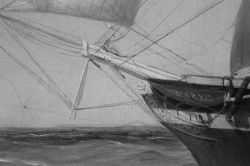
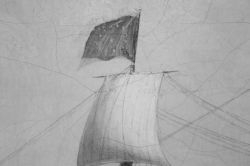
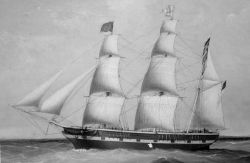
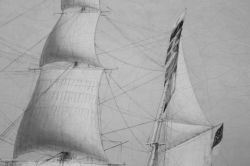

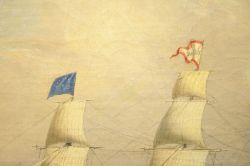
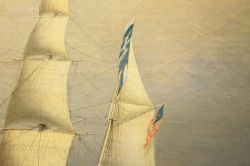
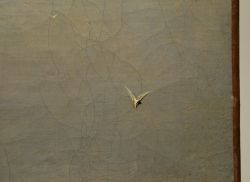
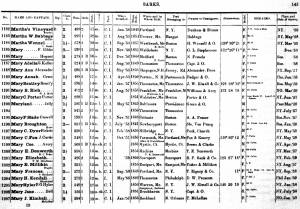

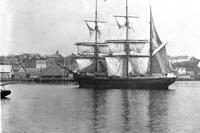

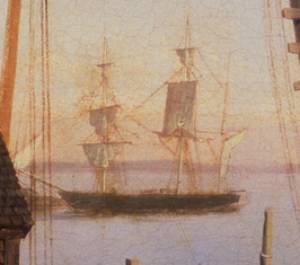


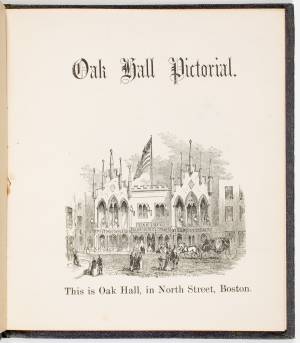
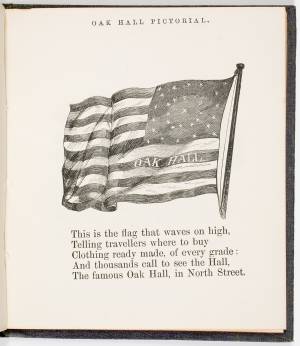



Commentary
The merchant bark “Mary” (268 register tons) was built at Medford, Massachusetts in 1844 by Foster & Taylor for Nathaniel Francis of Boston. This is a classic example of a formal ship portrait of the period, before Lane gave more original compositions to this genre. The vessel is depicted in strict profile under all plain sail in moderate seas with storm clouds approaching. A distant vessel at left, barely visible land at right, and three gulls (rarely depicted in a Lane vessel portrait) complete the scene. The detailed, accurate rigging and careful juxtaposition of color and values, particularily in the relationship between sea and clouds, makes this painting stand out from the usual vessel portraits of the day.
An interesting detail in this painting is the vessel’s ironwork, namely her anchor and the chain plates which secure the deadeyes and shrouds to the hull. Ships’ ironwork was usually primed with red lead, which was a dull red and often painted over to be less conspicuous. On some ships the opposite approach was taken and a bright red was used, if for no other reason than to relieve the monotony of a highly standardized color scheme.
Conservators’ infrared photographs of the painting reveal underdrawing typical of Lane’s vessel portraits, with full detailing of spars, rigging, and sail outlines (below). The differences in rigging leads between “as drawn” and “as painted” are negligible, virtually all other details follow the drawing exactly.
In this painting, in addition to the American flag (or ensign), “Mary” flies Elford’s telegraphic signal flags from her mizen topmast with code numbers 2, 5, 1, and 3 from top to bottom (5). Her name pennant flies at the main mast head and the Union Jack at the fore mast head.
The vessel’s construction was overseen by her master, a Captain Hopner, who commanded her for the three years under Francis’ ownership (1). Other accounts and records of this vessel differ considerably. Hall Gleason states that she was sold to New York parties, and in 1854 on a run from New Orleans to Stockholm, she was wrecked on Los Colorados Reef, Cuba on September, 1854, and burned (2). In Cutler’s history of American packet ships, “Mary” (268 tons) is listed as a “ship” (not a bark) under the management of the Packet Line of Boston in 1847 with Nathaniel Francis as master (3). In his six-volume treatise, “Merchant Sail,” William Armstrong Fairburn listed 58 vessels with the name “Mary,” none of them having the combination of rig, tonnage, and building date matching the “Mary” depicted by Lane (4). Her “official” records appear to have been lost.
–Erik Ronnberg
References:
1. Nathaniel Francis, “Sketch of Reminiscences of Former Years Requested by Nathaniel Francis, Son of the Author” (Boston: Typescript copy of probable manuscript, April 19, 1867).
2. Hall Gleason, “Old Ships and Ship-Building Days of Medford, 1630-1873” (West Medford, MA: published by the author, 1936), p. 66.
3. Carl C. Cutler, “Queens of the Western Ocean” (Annapolis, MD: U.S. Naval Institute Press, 1961), p. 449.
4. William Armstrong Fairburn, “Merchant Sail” (Center Lovell, ME: Fairburn Marine Educational Foundation, 1945-1955. Reprint: Gloucester, MA: Ten Pound Island Book Co., 1992). See index of vessels, Vol. 6.
5. M.V. Brewington, ‘Signal Systems and Ship Identification’ (Salem. MA: ,“The American Neptune”, Vol. iii, No. 3, July, 1943), pp. 211-215.
[+] See More